
![]()
~ ST. STEPHEN'S CHURCH ~
HACKINGTON NEAR CANTERBURY
Built in the 12th Century, the register dates from the year 1567
Restored in 1573 by Sir Roger Manwood
Churchyard plan in CCA, with grave positions and numbers marked 1936
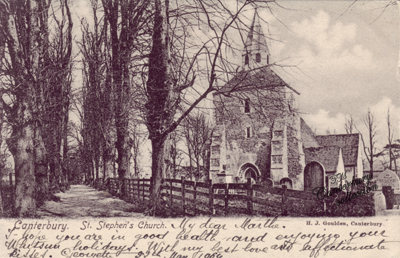
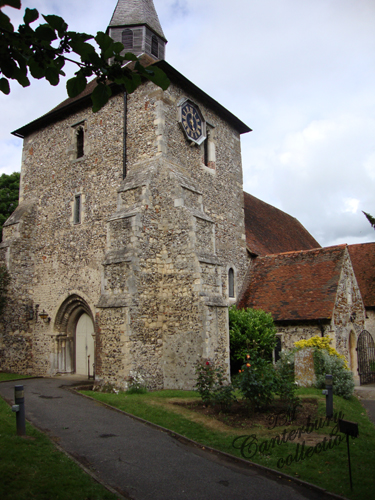

From Canterbury Views c. 1902/3
"St. Stephens, or Hackington, one mile north of Canterbury, and near the Stour, had an image of that saint, much resorted to by Pilgrims, from whence it had the name. It stood in the garden of Sir Roger Manwood, Ld. Chief Barron, who, in 1573, built 7 almshouses here. The manor aciently belonging to the monks of Christ Church, Canterbury; but Queen Elizabeth, granted it to Sir Roger Manwood, above-mentioned, whose grandson sold it to Sir Thomas Colepeper. King Edward III. on his return from France held a tournament here." EG 1751

Drawn by H. Gastineau after a sketch by Deeble, Engraved by Garner (bought as a single leaf)
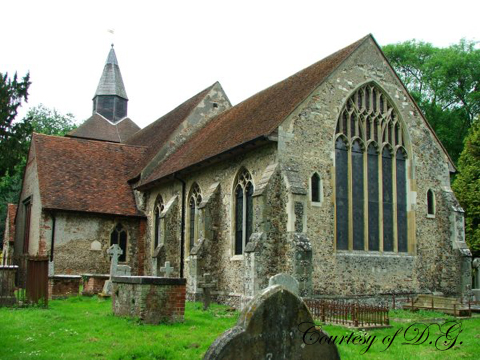
"St. Stephens, or Hackington (population 532) surrounded by trees of admirable growth and leafiness. The latter, we are told, is its proper name, and it owes its sobriquet of St. Stephens to an image of that saint which stood in the church, and was much visited by pilgrims on account of its supposed miraculous powers. It lies upon the slope of the hill, which here gently rises from the bank of the Stour, and looks out afar upon the glorious towers of sacred Canterbury. On one side are the almshouses, founded by pious Sir Roger Manwood; on the other side, near the church, stands Hale's Place (Miss Hales), commanding a very rich and interesting prospect.
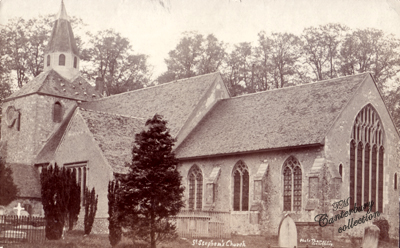
Archbishop Baldwin, temp. Henry II. commenced near the church, the foundation of a college for secular canons, but was stoutly opposed by the monks of Christ Church, who obtained a papal bull, enjoying the discomfited prelate to pull down what he had already erected, and pronouncing the site as "maledictum et profanum."
The manor formed part of the possessions of the Bellamonts, or Beaumonts, Earls of Leicester, and passed from the widow of Earl Robert, d. 1206 - who on her husbands death, devoted herself to the service of God at this place and was buried in 1219, in its church - Simon de Montfort, father of the great adversary of Henry III. In Queen Elizabeth's time it belonged to Sir Roger Manwood, Chief Baron of the Exchequer, who built here a large "Place House," or manorial mansion, where he died in 1592, founded the almshouses known by his name, and the Grammar School at Sandwich. In the south aisle of the church he erected a superb mausoleum for his family and himself.
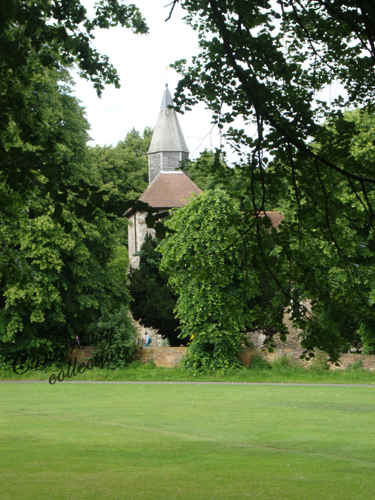
In 1675 the estate was sold to Sir Edward Hales (knighted by James II.) who formed a fine park, and was so ardent a loyalist that he accompanied the king on his flight from Sheppey, while a band of disaffected rioters was killing his deer and pillaging his house. His greatgrandson pulled down the ancient house, and erected the present commodious red brick Georgian mansion, which he surrounded with leafy groves and avenues of elms and chestnuts, and adapted it for the suitable residence of an English squire, despite the meanness of its architectural pretentions.
The Church dedicated to St. Stephen, is mainly an Early English building, and is of unusual interest. It is cruciform in design, with a nave, chancel, north and south transepts, and western tower, surmounted by a low spire, and strengthened by stalwart buttresses. The west door is Early English, but enriched with the Norman zigzag moulding. The south door inside the porch, and the arches of the transept, many be Norman, and belong, perhaps to an ancient building, enlarged and remodelled by Archbishop Baldwin. Observe the Decorated windows, inserted at a later period, and the large Perpendicular chancel-window. The font is Perpendicular, and was given by Sir Roger Manwood, about 1591. The whole church has recently been well restored, and gleams with the rich stained glass by Willement. In the transept, against the west wall, the tourist will not fail to observe the painted alabaster monument to Sir Roger Manwood, completed in 1592, before Sir Roger's death. There he may perceive the worshipful Chief Baron "in his habit as he lived," with his well-trimmed beard, his red robe, his coif, his black cap, and his SS collar.
 ___
___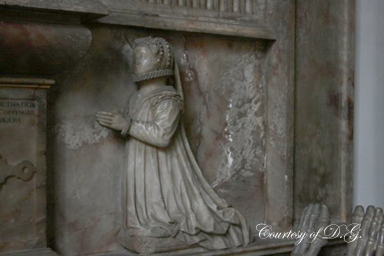
There are figures designed to represent his two wives, three sons, and two daughters and underneath, a skeleton "curiously carved in white marble," recumbent on a mattress.
A brass commemorates John Deve, vicar, d. 1473. Against the north wall is a singular painting of a monument of Queen Elizabeth, with her effigies lying at full length on a tomb; above is a canopy resting upon marble pillars, and enriched with various armorial bearings.
The vicarage, valued at £412, is in the patronage of the Archbishop of Canterbury." BGK1874
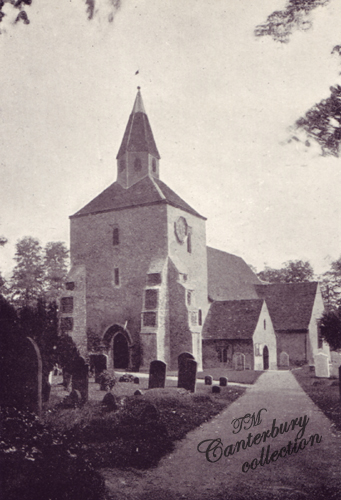
Marriage - March 6th, 1794 - At St. Stephen's near Canterbury, Mr. William GILES of Brotherhood-court, in that parish, to Miss Ann Vincent BLETCHYNDEN late of Bilsington priory. KR
Death February 28th, 1794, At his father's house at St. Stephen's near Canterbury, Mr. Mark Fielder CALLOW, only son fo Mr. John CALLOW. KR
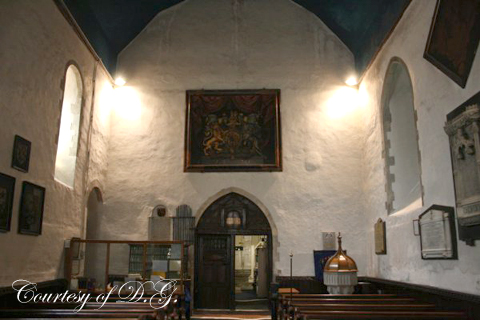
"Built in the twelfth century with the idea of making it a cathedral church, but this was stopped by Papal Bull. Restored in 1573 by Sir Roger Manwood, Baron of the Exchequer to Queen Elizabeth, whose tomb is seen in the church. There is some good screen work, and many monuments and other features of interest.
Register 1567. Eight Bells, Vicarage." 1910

A lovely view of the church and graveyard
"St. Stephen's, Hackington, is situated about a mile from the centre of the city, on the north. It is a charming spot, with the old church half hidden amidst surrounding circles of limes. The village is a quaint cluster of cottages and almshouses, an ancient inn, the village school, the adjacent farm, and the fine mansion of Hales Place, with its well timbered park containing a noble group of cedars.
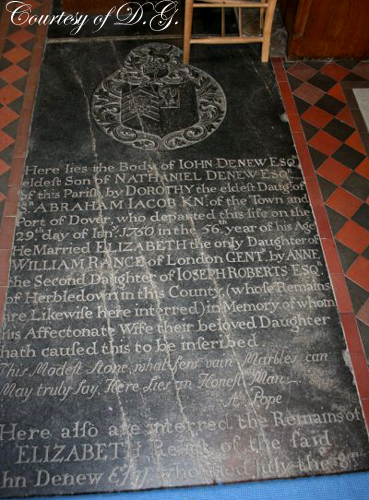
We must go back to the days of Stephen Langton for the origin of the intimate connection of this church with the Archdeacons of Canterbury. The great Archbishop, who had so large a share in the struggle between King John and the Barons, attached the living of Hackington to the Archdeaconry then held by his brother Simon. This Simon Langton had taken a notable part against John; he had been an active partizan of the French Dauphin, who made him his Chancellor. By the time John's son Henry had grown to manhood, Simon had grown "not only out of means, but also out of favour both with the King and Pope." It was then, however, that Stephen Langton provided handsomely for his brother by making him Archdeacon of Canterbury, and giving him the livings of St. Stephen's and Teynham. Simon removed the vicarage of Hackington, which long continued to be the residence of the Archdeacons, who had previously occupied a small house in St. Gregory's. He founded the Poor Priests' Hospital at Canterbury, and died in 1248, having held the archdeaconry for twenty-one years. Matthew Paris, the monk, says of him that, having upset the peace of two kingdoms, it was not wonderful that he became a pertuber and persecutor of his Church at Canterbury.
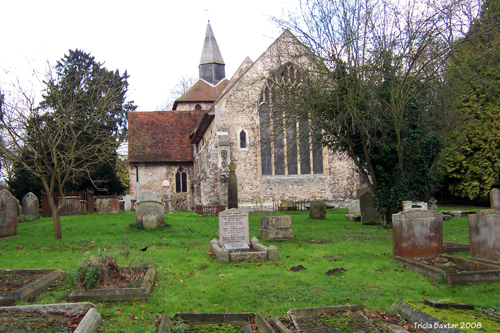
A view of St. Stephens churchyard
Hackington, as the residence of the Archdeacons of Canterbury during three centuries, must have been the home of many distinguished men. It was there that Archbishops Arundel and Warham died. It narrowly missed becoming a more important place. Archbishop Baldwin, who went with Coeur de Lion to the Crusades, and died in the Holy Land, began to build a college for secular canons at Hackington, but it was never completed, for the monks of Christ Church, with their Prior Alan, appealed to the Pope against the scheme, and a bull was issued commanding the Archbishop to pull down what he had erected.
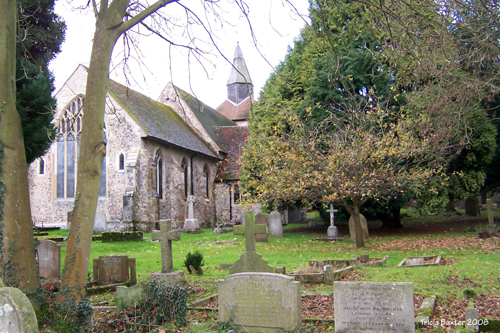
A view of St. Stephens churchyard
Hackington can boast of a connection with royalty. Edward III. held a tilt there on his return from the French war, and Henry VI. had a house and park there; these in the reign of Elizabeth were granted to Sir Roger Manwood. This worthy barrister, who became Chief Baron of the Exchequer, was a great benefactor to St. Stephen's, and founded the almshouses which serve to perpetuate his memory in the village. His mansion, which adjoined the churchyard, was no doubt the former residence of the archdeacons; it remained in the Manwood family till 1637, when the estate was sold to Colonel Colepepper. In 1675 Mr. E. Hales became the owner of it; he was knighted by James II., and it was his great grandson, Sir Edward Hales, Bart., who pulled down the old mansion and built, on the slope of the hill, the fine house which has within the last three years been so greatly altered and enlarged for St. Mary's Jesuit College.
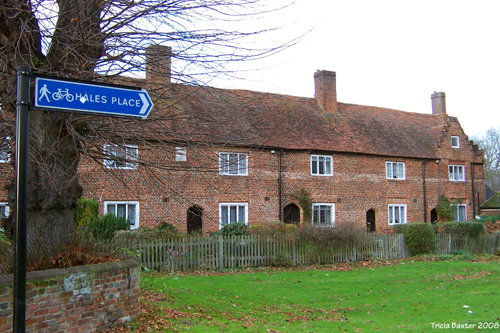
Manwood Almshouses
"Close to the church are the almshouses of Manwood's Hospital, six single houses, the seventh (a double house) the abode of the parish clerk. The last occupant (Edward Austen) held the office for the 64 years, and was one of the ringers of the two peals alluded to above. The patronage of the almshouses is attached to the ownership of the Hales' Estate." *He also founded the Grammar School at Sandwich
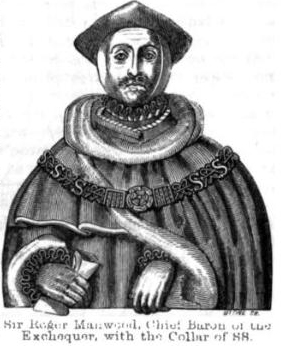
Sir Roger Manwood
The church is beautifully situated at the base of the hill, and is surrounded by rows of splendid lindens. It is cruciform in shape, the massively buttressed tower at the west end being equal in breadth to the nave. The west door is a most valuable example of the transition from the Norman, to which style its mouldings and capitals belong, but the arch is pointed. Through this door we enter into the belfry, from which a rather curious oak door leads into the nave. Over it is the date, 1630, and the text, "Let all things be done decently and in order." The tower contains eight bells, which are sweet toned and melodious. The St. Stephen's ringers have a reputation, and are not unmindful to place on record their efforts in the delightful art of change-ringing. A tablet tells us that the two trebles were added to the peal in 1845, when Holt's ten-part peal of 5040 grandsire triples was rung by the St. Stephen's Amateur Society in three hours and one minute. Another tablet records that in 1847 there was rung a true and complete peal of 6720 Bob-Major changes in four hours and three minutes.
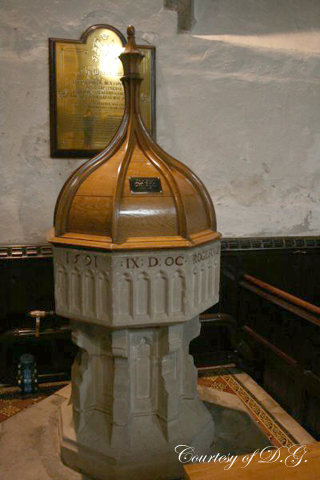
Within the south porch is a well preserved Norman doorway; the head of the arch is filled in with diapered squares, and the shafts have cushion capitals. One of the nave windows is Norman; the others are pointed.

The chancel arch is pointed, but the round transept arches are lighted by a handsome east window of five lights, with perpendicular tracery. The windows north and south of the chancel are very elegant; their tracery is apparently late Decorated merging into Perpendicular. The north transept has a three-light window which is worthy of notice. The stone font was presented by Sir Roger Manwood in 1591.
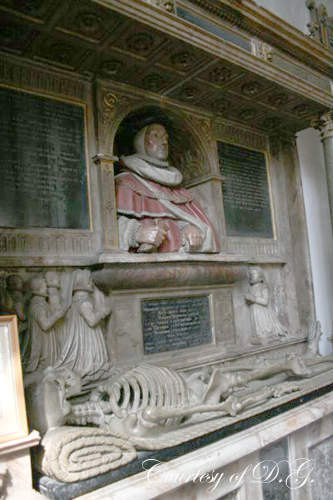 ___
___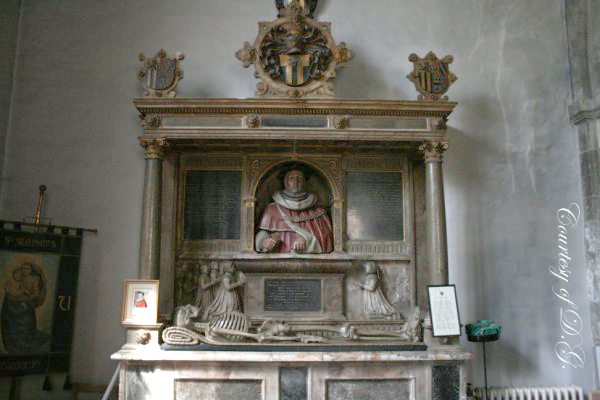
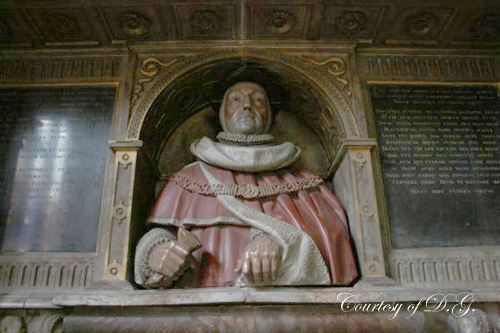
The most noteworthy of the monuments is that of Sir Roger Manwood in the south transept. It is of marble, and contains in a central niche a fine bust of the knight in his costume as Chief Baron of the Exchequer. Below are kneeling marble figures of his first wife Dorothy and their five children; on the other kneels his second wife Elizabeth without offspring. On the slab of the tomb, upon an admirably carved pallet of plaited rush, lies the effigy of Sir Roger in grim and bony nakedness. The skeleton is a clever work of woodcarving. Above the tomb are suspended a helmet, sword and gloves presumably those of Sir Roger, though his weapons were probably such as the arm of the law might wield. A Latin inscription tells us that amongst his other good works, he founded Sandwich School. He died in 1592." RROC
"A John Gower was vicar of the church of St. Stephen, alias Hackington in Kent, and died there on the 27th of December, 1457, and it may have been the same person who, by the title of "John Gower, Clerk, of the parish of St. Dunstan's near Canterbury, was a feoffee of the lands of William Spycer in Hackington, on the 9th September, 20 Henry VI. 1442. 1828
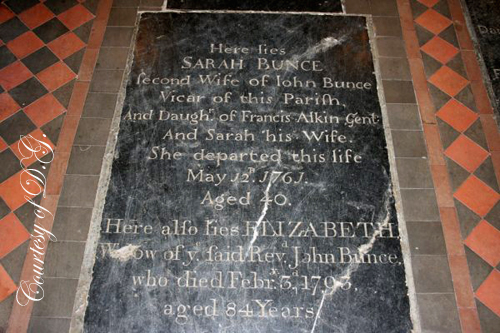 ____
____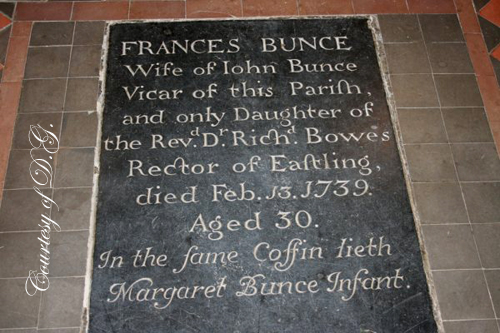
"In the village of St. Stephen's, near Canterbury, is a beautiful shaded walk of very fine lime trees adjoining the churchyard, and leading to the meadows. The following Elegy was composed in an evening walk there, to the memory of the author's grandfather, the Rev. John Bunce, A.M. formerly Vicar of Brensett, in Romney Marsh, Kent, and afterwards Rector of Chingford and Pitsey in Essex, and other relatives buried in the chancel of St. Stephen's Church." (poem) GM 1810 (poem p. 261, Canterbury May 31 W.B.)
The area is 1,867 acres of land and 1 of water, the population in 1901 was 617
"July 2, 1810, Aged 84, at the house of her sister Mrs. Willyams, at St. Stephen's, near Canterbury, Mrs. Mary Goodere, elder surviving sister of the late Sir Edward Goodere and Sir John Dinely, barts. (See Gent. Mag. vol. LXV. pp. 1055 and 1115, and vol. LXXIX. p. 1171) This excellent woman passed through her long life in the constant practice of every virtue. She was in the strictest sense of the word a Christian; for she made the doctrines and example of the most benevolent of beings the unremitted object of her thoughts, and of her imitation. Her loss is deeply felt, and sincerely regretted by her* family and friends." GM 1810 *says him
1820 "Deaths (May) At Saint Stephen's, near Canterbury, Frances, daughter of the Rev. Henry Plumptre." GM 1820
1822 "Marriage, July 1, Harry Wm. Carter, esq. M.D. and F.R.S.E. of Canterbury, to Louisa, dau. of Rev. H. Plumptre, L.L.B. Rector of Claypole, near Newark." GM July 1822
" Death - June Rev. Allen Fielding, of St. Stephen's, Canterbury, V. of Shepherd's Well, Kent, of Hadington, and R. of St. Cosmas and Damian, in the Blean. He was the second son of Fielding the novelist." The Investigator (Quarterly Magazine) 1823
"March 31 at St. Stephen's Canterbury, Susanna Bonella, relict of Rev. G. Gipps, Rector of Ringwould." GM 1823
August 22, 1831, Death at Camberwell, age 77, William Bunce, esq. son of the Rev. J. Bunce, who died in 1786, having been Vicar of St. Stephen's near Canterbury, for more than half a century (see our vol. I.VI. p. 1002)" GM 1831
"Monmouth - Death, Sept 13, at Chepstow, Amelia, widow of Charles James Swann, esq. of Lincoln's Inn, Barrister-at-Law, third dau. of the late Rev. Allen Fielding, Vicar of St. Stephen's, Canterbury." GM 1834
"Death, lately. At St. Stephen's, near Canterbury, G. Baker, esq. Recorder of Dover." GM1834
1850 - Subscribers from "Morals on the Book of Job", 1850 - Rev. Robert Fraser, St. Stephen's, Canterbury
"Death - Aged 51, Jemima, widow of Richard Marsh, esq. of St. Stephen's, Canterbury and eldest daughter of the late Charles Fourdrinier, esq. of Lower Tooting, Surrey." GM Jan - June 1853
"Marriage - At Portsea, the Rev. A. N. Bredin, Rector of Taney, Dublin, eldest son of the late Major-Gen. Bredin, Royal Art. to Harriett Pemell, eldest daughter of Peter Pemell, esq. of St. Stephen's Canterbury." GM 1853
"Death, at St. Stephen's vicarage, Canterbury, aged 17, George-Baker, eldest son of the Rev. John White.". GM1854
"Death, November 7th, at Canterbury, aged 82, John Furley, esq. many years managing partner of the Canterbury Bank. His remains were interred in the family vault lately constructed in St. Stephen's Churchyard, adjacent to that city." GM1855
1858 - Rev. J. White
"Marriage at St. Stephen's near Canterbury, John William Zorapore Wright, late Lieut. 2nd Dragoon Guards, son of Major General Wright, C.B. to Mary Ann daughter of the Rev. John White." AR1860
"Marriage June 14, at St. Stephen's near Canterbury, John William Zorapore Wright, late Lieut. 2nd Dragoon Guards, eldest son of Maj.-General Wright, C.B., late 39th Reg., to Mary Ann, eldest daughter of the Rev. John White, Vicar of St. Stephen's, near Canterbury." GM1860
"At Oakwell, Kent, aged 67, Margaret, widow of the Rev. James Hamilton, Vicar of St. Stephen's, near Canterbury." GM1861
"Death, Mary widow of George Baker, A. M., barrister at law and Recorder of Dover, of Beverley, St. Stephen's, near Canterbury, and eldest daughter of the late Very Rev. Gerrard Andrews, D.D., Dean of Canterbury." GM1863
"June 8th, 1865, Marriage at St. Stephens, Canterbury, the Rev. J. P. Alcock, M.A., Pickley, to Katharine, second dau. of the late John Furley, esq., of Canterbury." GM1865
1889 - Rev. Frederick Harrison Hichens, M.A., Vicar
1903 - the living is a rectory, net yearly value £340, with half an acres of glebe and residence, in the gift of the Archdeacon of Canterbury, and held since 1886 by the Rev. Frederick Harrison Hichens M.A. of Exeter College, Oxford, and hon. canon of Canterbury.
1903 - Parish Clerk - William Banks
1917 - Rector, Rev. P.P. Somerville (A.K.C.); Churchwardens, Capt. Cecil Frederick Oldham and Mr. E.B. Mason